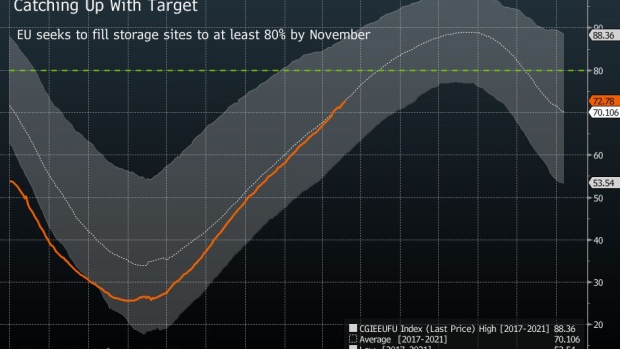Aug 12, 2022
Mild Start to Winter Could Limit Europe’s Impending Energy Shock
, Bloomberg News

(Bloomberg) -- European households fretting over turning on the heating and governments worried about running out of gas may take some solace from weather forecasts: the start of winter looks mild.
Above-normal temperatures are projected in Europe in October, when the heating season usually starts, according to early long-range forecasts by Maxar Technologies LLC and Marex.
The preliminary outlook is a bit of good news for economies, consumers and industries hurting over spiraling energy costs, with the crisis expected to only worsen during peak winter demand. A balmy October could curb usage and give more time to refill gas inventories that will be critical as the months turn colder.
Europe’s energy crunch has led to many households struggling to pay bills and the threat of winter blackouts. Prices are near a record high amid Russian gas-flow cuts, while summer heat waves have boosted cooling demand and lowered water levels on the key Rhine River, disrupting the movement of energy products.
“Some themes from summer will bleed into the first half of autumn across Europe, especially central, southern, and western Europe,” said Tylor Roys, a meteorologist at AccuWeather in State College, Pennsylvania, which is finalizing its October forecast. Any cool snaps are more likely to come in November for eastern Europe, he said.
Warm Atlantic weather and high pressure anomalies will bring drier conditions over most of western and southern Europe in October, said Alexandre Fierro, a senior meteorologist at Marex in London. Temperatures could be 1-1.5 degrees Celsius (1.8-2.7 Fahrenheit) above normal.
A La Nina pattern will also contribute to above-average temperatures in northwest Europe for October, Maxar senior meteorologist Steven Silver said.
Supply Uncertainty
While that may curb consumption, there are still many uncertainties over winter supplies.
There’s the threat of Russia curbing more gas flows and less power coming from France and Norway due to nuclear and hydro issues. Europe’s liquefied natural gas imports -- now running at a seasonal record -- face competition from Asia when winter purchases ramp up there. Plus, coal plants are already being revived to ensure supplies.
Gas withdrawals from storage sites typically start at the end of October. That can happen earlier in the month if there’s a chilly start to winter, while a mix of warm weather and good supply can prolong refilling into November.
Europe’s gas stockpiles are about 72.8% full, near the five-year average. Trader Energi Danmark this week said there’s growing confidence the region’s inventories will meet European Union targets by late autumn.
Putin’s Gas Weapon Blunted by Europe’s Stock Build: StanChart
Still, how Russian supplies fare will remain crucial. The key Nord Stream pipeline bringing fuel to Europe is operating at 20% of capacity and that can change depending on the Kremlin.
Without Nord Stream, and if winter is cold, gas storage could run out by late February, Wood Mackenzie Ltd. has said.
©2022 Bloomberg L.P.





